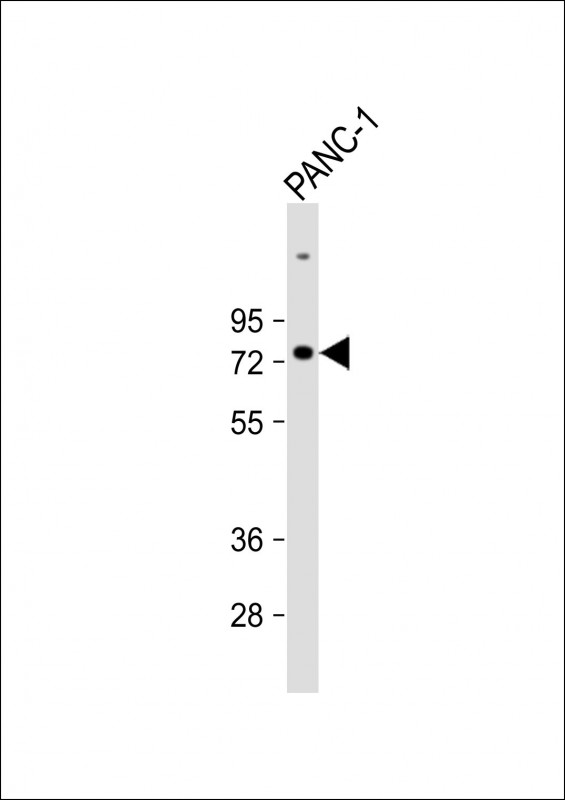SENP1 Antibody (C-term)
Purified Rabbit Polyclonal Antibody (Pab)
- 产品详情
- 文献引用 : 2
- 实验流程
- 背景知识
Application
| WB, E |
|---|---|
| Primary Accession | Q9P0U3 |
| Other Accession | P59110 |
| Reactivity | Human |
| Predicted | Mouse |
| Host | Rabbit |
| Clonality | Polyclonal |
| Isotype | Rabbit IgG |
| Calculated MW | 73481 Da |
| Antigen Region | 560-590 aa |
| Gene ID | 29843 |
|---|---|
| Other Names | Sentrin-specific protease 1, Sentrin/SUMO-specific protease SENP1, SENP1 |
| Target/Specificity | This SENP1 antibody is generated from rabbits immunized with a KLH conjugated synthetic peptide between 560-590 amino acids from the C-terminal region of human SENP1. |
| Dilution | WB~~1:1000 E~~Use at an assay dependent concentration. |
| Format | Purified polyclonal antibody supplied in PBS with 0.09% (W/V) sodium azide. This antibody is prepared by Saturated Ammonium Sulfate (SAS) precipitation followed by dialysis against PBS. |
| Storage | Maintain refrigerated at 2-8°C for up to 2 weeks. For long term storage store at -20°C in small aliquots to prevent freeze-thaw cycles. |
| Precautions | SENP1 Antibody (C-term) is for research use only and not for use in diagnostic or therapeutic procedures. |
| Name | SENP1 |
|---|---|
| Function | Protease that catalyzes two essential functions in the SUMO pathway (PubMed:10652325, PubMed:15199155, PubMed:15487983, PubMed:16253240, PubMed:16553580, PubMed:21829689, PubMed:21965678, PubMed:23160374, PubMed:24943844, PubMed:25406032, PubMed:29506078, PubMed:34048572, PubMed:37257451). The first is the hydrolysis of an alpha-linked peptide bond at the C-terminal end of the small ubiquitin- like modifier (SUMO) propeptides, SUMO1, SUMO2 and SUMO3 leading to the mature form of the proteins (PubMed:15487983). The second is the deconjugation of SUMO1, SUMO2 and SUMO3 from targeted proteins, by cleaving an epsilon-linked peptide bond between the C-terminal glycine of the mature SUMO and the lysine epsilon-amino group of the target protein (PubMed:15199155, PubMed:16253240, PubMed:21829689, PubMed:21965678, PubMed:23160374, PubMed:24943844, PubMed:25406032, PubMed:29506078, PubMed:34048572, PubMed:37257451). Deconjugates SUMO1 from HIPK2 (PubMed:16253240). Deconjugates SUMO1 from HDAC1 and BHLHE40/DEC1, which decreases its transcriptional repression activity (PubMed:15199155, PubMed:21829689). Deconjugates SUMO1 from CLOCK, which decreases its transcriptional activation activity (PubMed:23160374). Deconjugates SUMO2 from MTA1 (PubMed:21965678). Inhibits N(6)-methyladenosine (m6A) RNA methylation by mediating SUMO1 deconjugation from METTL3 and ALKBH5: METTL3 inhibits the m6A RNA methyltransferase activity, while ALKBH5 desumoylation promotes m6A demethylation (PubMed:29506078, PubMed:34048572, PubMed:37257451). Desumoylates CCAR2 which decreases its interaction with SIRT1 (PubMed:25406032). Deconjugates SUMO1 from GPS2 (PubMed:24943844). |
| Cellular Location | Nucleus. Cytoplasm Note=Shuttles between cytoplasm and nucleus |
| Tissue Location | Highly expressed in testis. Expressed at lower levels in thymus, pancreas, spleen, liver, ovary and small intestine |
For Research Use Only. Not For Use In Diagnostic Procedures.

Provided below are standard protocols that you may find useful for product applications.
BACKGROUND
SENP1 is a protease that catalyzes two essential functions in the SUMO pathway: processing of full-length SUMO1, SUMO2 and SUMO3 to their mature forms and deconjugation of SUMO1, SUMO2 and SUMO3 from targeted proteins. SENP deconjugates SUMO1 from HIPK2 and from HDAC1, which decreases the transcriptional repression activity of the latter.
REFERENCES
Gong, L., et al., J. Biol. Chem. 275(5):3355-3359 (2000).
Bailey, D., et al., J. Gen. Virol. 83 (Pt 12), 2951-2964 (2002).
终于等到您。ABCEPTA(百远生物)抗体产品。
点击下方“我要评价 ”按钮提交您的反馈信息,您的反馈和评价是我们最宝贵的财富之一,
我们将在1-3个工作日内处理您的反馈信息。
如有疑问,联系:0512-88856768 tech-china@abcepta.com.






















 癌症的基本特征包括细胞增殖、血管生成、迁移、凋亡逃避机制和细胞永生等。找到癌症发生过程中这些通路的关键标记物和对应的抗体用于检测至关重要。
癌症的基本特征包括细胞增殖、血管生成、迁移、凋亡逃避机制和细胞永生等。找到癌症发生过程中这些通路的关键标记物和对应的抗体用于检测至关重要。 为您推荐一个泛素化位点预测神器——泛素化分析工具,可以为您的蛋白的泛素化位点作出预测和评分。
为您推荐一个泛素化位点预测神器——泛素化分析工具,可以为您的蛋白的泛素化位点作出预测和评分。 细胞自噬受体图形绘图工具为你的蛋白的细胞受体结合位点作出预测和评分,识别结合到自噬通路中的蛋白是非常重要的,便于让我们理解自噬在正常生理、病理过程中的作用,如发育、细胞分化、神经退化性疾病、压力条件下、感染和癌症。
细胞自噬受体图形绘图工具为你的蛋白的细胞受体结合位点作出预测和评分,识别结合到自噬通路中的蛋白是非常重要的,便于让我们理解自噬在正常生理、病理过程中的作用,如发育、细胞分化、神经退化性疾病、压力条件下、感染和癌症。






